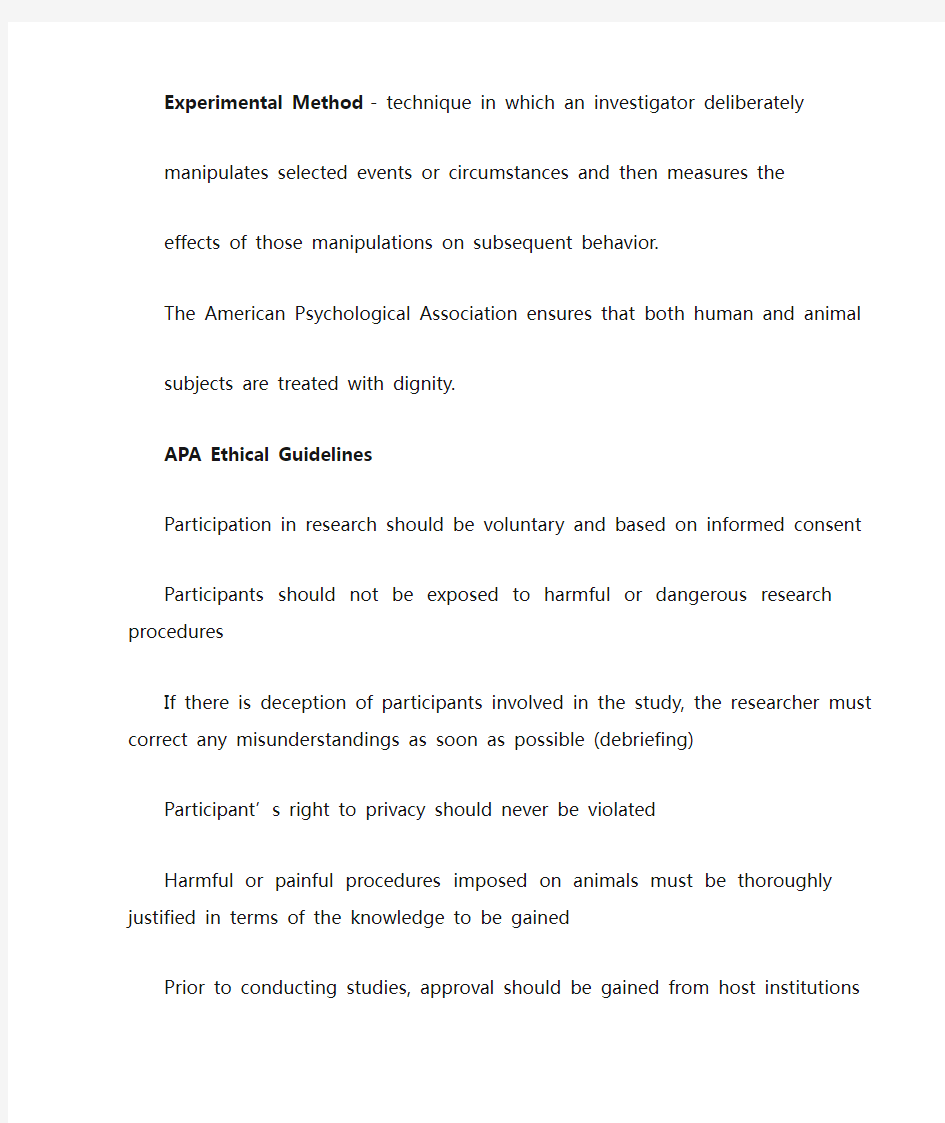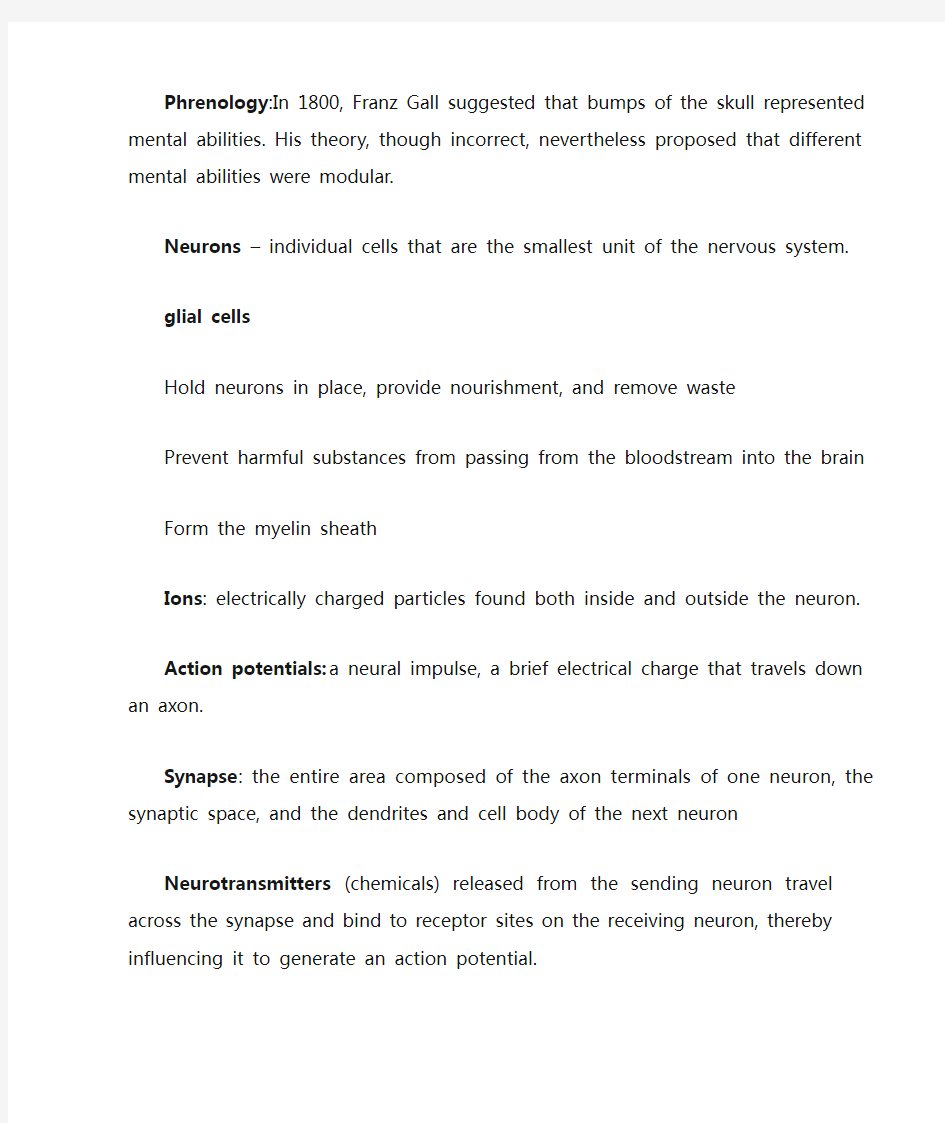Experimental Method


Experimental Method - technique in which an investigator deliberately manipulates selected events or circumstances and then measures the
effects of those manipulations on subsequent behavior.
The American Psychological Association ensures that both human and animal subjects are treated with dignity.
APA Ethical Guidelines:
Participation in research should be voluntary and based on informed consent Participants should not be exposed to harmful or dangerous research procedures
If there is deception of participants involved in the study, the researcher must correct any misunderstandings as soon as possible (debriefing)
Participant’s right to privacy should never be violated
Harmful or painful procedures imposed on animals must be thoroughly justified in terms of the knowledge to be gained
Prior to conducting studies, approval should be gained from host institutions Phrenology:In 1800, Franz Gall suggested that bumps of the skull represented mental abilities. His theory, though incorrect, nevertheless proposed that different mental abilities were modular.
Neurons–individual cells that are the smallest unit of the nervous system.
glial cells
Hold neurons in place, provide nourishment, and remove waste
Prevent harmful substances from passing from the bloodstream into the brain
Form the myelin sheath
Ions: electrically charged particles found both inside and outside the neuron.
Action potentials: a neural impulse, a brief electrical charge that travels down an axon.
Synapse: the entire area composed of the axon terminals of one neuron, the synaptic space, and the dendrites and cell body of the next neuron
Neurotransmitters (chemicals) released from the sending neuron travel across the synapse and bind to receptor sites on the receiving neuron, thereby influencing it to generate an action potential.
The Endocrine System is the body’s “slow”chemical communication system. Communication is carried out by hormones synthesized by a set of glands.
Types of Neurons:
Sensory (Afferent) Neurons
Motor (Efferent) Neurons
Interneurons (Association) Neurons
Cerebral Cortex: The intricate fabric of interconnected
neural cells that covers the cerebral hemispheres.
Divided into four lobes that are separated by prominent
fissures:
Frontal Lobe
Parietal Lobe
Occipital Lobe
Temporal Lobe
Brainstem: responsible for automatic survival functions.
Cerebellum: regulates reflexes and balance and coordinates movement. Thalamus: relay station for sensory information.
Limbic System: responsible for emotions such as fear and aggression along with drives for food and sex.
Corpus Callosum: thick band of nerve fibers connecting the left and right cerebral hemispheres allowing them to work as a coordinated unit.
How do we construct our representations of the external world?
To represent the world, we must detectphysical energy from the environment and convert it into neural signals. This is a process called sensation.
When we select, organize, and interpret our sensations, the process is called perception.
Absolute Threshold: the least amount of energy that can be detected as a stimulation 50% of the time.
Adaptation: automatic adjustment of our senses to the overall level of stimulation in a particular setting.
Retina: The light-sensitive inner surface of the eye, containing receptor rods and cones in addition to layers of other neurons that process visual information.
The Receptor Cells: the retina contains the receptor cells for vision which are sensitive to electromagnetic energy.
Two types of receptors:
Rods–receptor cells in the retina responsible for night vision and perception of brightness.
Cones–receptor cells in the retina responsible for color vision.
Blind Spot: the place on the retina where the axons of all the ganglion cells leave the eye and where there are no receptors.
Theories of Color Vision
1 Trichromatic (three color) Theory: the theory of color vision that holds that all color perception derives from three different color receptors (usually red, green, and blue).
2. Opponent-Process Theory: theory of color vision that holds that three sets of color receptors (yellow-blue, red-green, and black-white) respond to determine the color you experience.
1. Intensity differences
2. Time differences
Time differences as small as 1/100,000 of a second can cause us to localize sound. The head acts as a “shadow”or partial sound barrier.
Touch
The sense of touch is a mix of four distinct skin senses: pressure, warmth, cold, and pain.
Taste Buds: structures on the tongue that contain the receptor cells for taste (found on the tip, sides, and back of the tongue).
Olfactory Bulb: the smell center in the brain.
Kinesthetic Senses: senses of muscle movement, posture, and strain on muscles and joints.
Retinal disparity: Images from the two eyes differ.
Gestalt psychologists showed that a figure formed a “whole”different from its surroundings.
Depth Perception
Relative Size: If two objects are similar in size, we perceive the one that casts a smaller retinal image to be farther away.
Interposition: Objects that block other objects tend to be perceived as closer.
Linear Perspective: Parallel lines, such as railroad tracks, appear to converge in the distance. The more the lines converge, the greater their perceived distance.
Visual Illusions: result from false and misleading depth cues.
Physical: cause of the illusion is in the behavior of the light before it reaches the eye causing us to see something that isn't physically there
Perceptual: occur because the stimulus contains misleading cues that give rise to inaccurate or impossible perceptions.
Apparent Movement: occurs when we perceive movement in objects that are actually standing still.
The ability to perceive or acquire information without using the ordinary senses is called Extrasensory Perception (ESP).
Types of Extrasensory Perception
1. Telepathy: Mind-to-mind communication; one person sending thoughts and the other receiving them.
2. Clairvoyance: Perception of remote events, such as sensing a friend’s house on fire.
3.Psychokinesis: mind over matter where people can levitate objects or influence
the movement of an object.
Perceptual Set
A mental predisposition to perceive one thing and not another. Examples of perceptual set:
Parapsychology: field of study focusing on ESP and other psychic phenomenon
